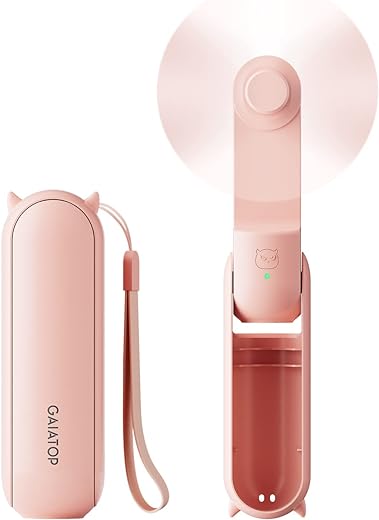
In this step-by-step guide, you will learn how to replace the blades of a portable fan. Whether you need to replace damaged blades or want to upgrade to a new set, this guide will provide you with all the necessary instructions. Simply follow the steps outlined in the guide and you’ll have your fan blades replaced in no time.
Stay cool with our top picks!
Gather necessary tools
Before you start, gather the necessary tools. Begin by obtaining a screwdriver, ideally a Phillips-head one, which will be used throughout the process. Additionally, you will need a pair of pliers to assist with any tight or stubborn fittings. Lastly, ensure you have a new set of fan blades on hand, which will be essential for replacing the old ones. Having these tools ready will enable you to proceed smoothly with the task at hand.
Disconnect the power
For your safety, please unplug the portable fan from the power source or remove the batteries if it’s a battery-powered fan. This will prevent any potential electric shocks or accidents while handling the fan. Simply disconnecting the power source will ensure that the fan is completely powered off and safe to handle.
Remove the fan grille
To remove the fan grille, start by using a screwdriver to locate and remove any screws that are holding it in place. If you don’t see any screws, check for clips or latches that need to be released. Gently pry or unhook these clips or latches to detach the fan grille. Be sure to store the screws in a safe place for reassembly later.
Detach the fan blades
To detach the fan blades, start by removing the grille as mentioned in the previous step. Once the grille is off, locate the fan blades. Check whether they are secured with screws or snapped into place. If there are screws, use a screwdriver to carefully remove them. If they are snapped into place, gently pull or pry them off, ensuring not to force or damage the blades.
Replace the old blades
To replace the old blades, first, take the new set of fan blades and align them with the motor shaft. Make sure they are securely attached by either screwing them in or snapping them into place. Double-check that the blades are properly aligned and tightly secured to ensure safe and efficient operation.
Reinstall the fan grille
To reinstall the fan grille, follow these steps:
- Carefully position the fan grille back into its original place.
- Ensure that all screws, clips, or latches are properly secured to hold the grille in place.
- Double-check that the grille is aligned correctly and sits flush with the surrounding surface.
- Test the grille’s stability by gently pushing on different areas to ensure it doesn’t move or come loose.
Remember, a properly installed fan grille helps maintain optimal airflow and protects the fan from debris.
Reconnect the power
To reconnect the power to your portable fan, simply plug it back into the power source. Make sure the power cord is securely inserted into the fan and the electrical outlet. Alternatively, if your fan operates on batteries, replace them with fresh ones if necessary. This will ensure that your fan is ready to provide you with a cool breeze once again.
Test the fan
To test the fan, start by turning it on and observe if the blades are spinning smoothly. If you notice any irregularities, carefully check the attachment of the blades and make the necessary adjustments.
Clean the fan
To clean the fan thoroughly, follow these steps:
- Start by disassembling the fan carefully, making sure to unplug it from the power source.
- Use a soft brush or cloth to remove any dust or debris from the grille, blades, and other parts of the fan. You can also use a vacuum cleaner with a brush attachment for this task.
- If there are stubborn stains or dirt, you can dampen the cloth slightly with water or a mild cleaning solution, but be cautious not to get any liquid inside the fan motor.
- Once you have cleaned all the parts, allow them to air dry completely before reassembling the fan.
Remember to always refer to the manufacturer’s instructions for specific cleaning recommendations and safety precautions.
Final inspection
Inspect the fan thoroughly, checking that all components are securely in place. Start by examining the blades, ensuring they are clean and not damaged. Next, inspect the motor for any loose connections or signs of wear. Then, examine the grill and housing for any debris or obstructions. Finally, switch on the fan and listen for any unusual noises or vibrations. If everything looks and sounds normal, the fan is ready to be returned to regular use.
Wrap it up
Conclusion:
In conclusion, learning how to replace the blades of a portable fan is a straightforward process that can greatly enhance your cooling experience. By following the simple steps outlined in this blog post, you can easily refresh your fan and ensure its optimal efficiency. So, don’t hesitate to give it a try and enjoy the cool breeze of a well-functioning fan once again!
What you’ll need
Maintenance Made Easy
Getting the most out of your portable fan
- Open the packaging and remove the portable fan
- Locate the power switch or button on the fan and turn it on
- Adjust the fan speed according to your preference. Most portable fans have multiple speed settings
- Hold the fan in your hand or place it on a flat surface, depending on the design and style of the fan
- Direct the airflow towards yourself or in the desired direction by adjusting the fan’s angle or position
- Enjoy the cool breeze generated by your portable fan!
- When you’re done, turn off the fan and safely store it in a secure place until next use
Answers to your burning questions about portable fans
What are the price ranges for portable fans?
The price ranges for portable fans can vary depending on factors such as brand, size, features, and quality. Generally, you can find portable fans starting from around $10 to $100 or more. Basic models with simple features like adjustable speed and direction tend to be more affordable, while those with additional features like remote control, built-in timers, or oscillation tend to be on the higher end of the price spectrum. Keep in mind that prices may also differ based on the type of portable fan, such as desk fans, tower fans, or handheld fans. It’s always a good idea to compare prices and read reviews before making a purchase to ensure you’re getting the best value for your money.
How does a portable fan work?
A portable fan works by utilizing an electric motor to spin a set of blades or impellers. When you turn on the fan and provide it with electricity, the motor starts rotating the blades. As the blades turn, they create a flow of air by pushing and pulling it in the direction they are spinning.
The air in the surrounding environment is drawn into the fan through the front grille or blades. As the blades spin, they push this air out through the back of the fan or through the grille’s openings. This movement of air creates a breeze that helps to cool you down.
In addition to cooling, portable fans can also help with ventilation by circulating stale air and improving air circulation in a room. They are designed to be lightweight and easy to move around, allowing you to bring them wherever you need a cool breeze.
It’s important to note that portable fans do not actually lower the temperature of the air. Instead, they create a perceived cooling effect by increasing the air movement and promoting evaporation of moisture from your skin, which can make you feel more comfortable.
Overall, portable fans are handy devices that rely on the principles of airflow and movement to provide a refreshing breeze wherever you need it.
What are the different types of portable fans available in the market?
There are several different types of portable fans available in the market. Some of the most common ones include:
- Table Fans: These are compact fans designed to be placed on tables or desks. They are portable and provide localized cooling.
- Tower Fans: Tower fans are slim and vertical in shape, taking up less space. They usually have a tall design and provide a wider area of airflow.
- Bladeless Fans: Bladeless fans are innovative in design as they use air multiplier technology to create a smooth and consistent airflow. They are safe and easy to clean.
- Handheld Fans: Handheld fans are small, lightweight, and designed to be held in the hand. They are great for personal use and can be easily carried around.
- Clip-on Fans: These fans have a clip-on feature that allows them to be attached to various surfaces like desks, chairs, or strollers. They are versatile and convenient.
- USB Fans: USB fans are powered by a USB connection, making them compatible with a variety of devices such as laptops, power banks, and car chargers. They are ideal for travel.
- Misting Fans: Misting fans spray a fine mist of water along with the airflow to provide a cooling effect. They are perfect for outdoor use, especially in hot and dry climates.
- Rechargeable Fans: Rechargeable fans are battery-operated and can be charged using a USB cable or a power outlet. They are convenient for use during power outages or when on the go.














Could you also provide a guide on how to clean the motor of a portable fan? It would be helpful to know the proper steps and tools required for this maintenance task.
I recently replaced the blades of my portable fan and found that using a magnetic screwdriver made the process much easier. It helped me avoid dropping the screws and made it easier to attach the new blades securely. Highly recommend giving it a try!
Replacing the blades of a portable fan can extend its lifespan and improve its performance. It’s a great DIY project for those looking to save some money and avoid buying a new fan. Plus, it’s satisfying to see the difference in airflow once the new blades are in place!
When replacing the blades, it’s important to make sure they are properly aligned and balanced. If the blades are not balanced, it can lead to vibrations and noise when the fan is in use. I suggest using a balancing kit to ensure smooth operation.